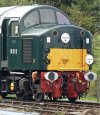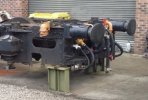On the topic of crew protection there have been numerous accidents involving bonneted locos, how many have resulted in serious injuries or deaths with the crew? 45147 not included in this one as don't think that was survivable with any design. Would be interesting to compare with similar accidents in flat fronted designs.
I've been thinking about this; to the best of my knowledge, the list of accidents where there were fatalities in diesel or electric loco cabs (serious injuries would, I suspect, be a considerably longer list) is:
Class 20: Nottingham (Lenton S Jcn) 1971, Worksop 1989 (the only evidence for the latter accident is an unreferenced statement on Wikipedia)
Class 24: Castlecary 1968, Kidsgrove 1973
Class 25: Middlesbrough 1971, Nottingham (Lenton S Jcn) 1971, Newton-on-Ayr 1976
Class 27: East Langton 1965
Class 31: Hatfield 1968, Corby 1975, Chinley 1986
Class 33: Itchingfield Jcn 1964, Hilsea-Fratton 1979, Holton Heath 1989
Class 40: Acton Grange Jcn 1966, Copy Pit (Cornholme) 1967
Class 43 (HST): Ladbroke Grove 1999, Ufton Nervet 2004, Carmont 2020
Class 45: Stanton Gate 1963, Peterborough N 1968, Bridgwater 1974, Eccles 1984 (this is 45147, the one Richard mentioned).
Class 46: Naas (near Lydney) 1979
Class 47: Bridgend 1965 (also mentioned in this thread), Monmore Green 1969, Cheadle Jcn-Northenden 1971, Eltham Well Hall 1972, Leicester (Humberstone Rd Jcn) 1972, Carstairs 1975, Eastriggs 1976 (collision with lorry that came off overbridge), Farnley Jcn 1977, Invergowrie 1979, Crewe 1980, Micheldever 1986, West Brompton 1989
Class 50: Beattock 1969
Class 52: Knowle & Dorridge 1963, Worcester Tunnel Jcn 1976
Class 56: Morpeth 1992
Class 66: Great Heck 2001
Class 81: Hixon 1968, Linslade 1982
Class 83: Watford Jcn 1975
Class 85: Warrington 1989
Class 86: Wigan North Western 1984, Colwich 1986
This list may not be 100% complete as regards collisions not on running lines. Almost all of the accidents have reports on the Railways Archive. I don't know whether the numbers are susceptible to any kind of meaningful analysis - I'm sure they're affected by, among other things, the prevailing standards of rail safety in the era when the locos in question were active and the types of traffic that they worked. That said, the number of class 47 accidents stands out, but the Peaks actually seem to perform worse relative to numbers built. On the other hand, the lack of fatalities involving the class 37 seems notable.



